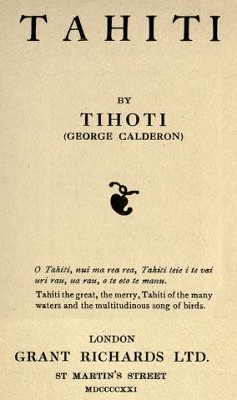
george calderon : legend of hiro and marama, 1921
| home | catalogue | history | references | appendix |
 |
surfresearch.com.au
george calderon : legend of hiro and marama, 1921 |
Open Library
http://openlibrary.org/books/OL7085433M/Tahiti
Louis took me
to the house of Tipu to get parapores or legends.
He lived in a
little house in a garden neatly laid out in rows of taro and umara (potatoes).
Potatoes are
not eaten by the natives ; they are a delicacy for the European.
...
He produced a
big book ruled with lines for money, like a ledger.
He swept the
fleas from his page as he read.
I transcribed
the first page or two of his book and promised I would show it to no one
in Tahiti.
This book was
written in parau huna (a secret writing).
Suddenly he grew
suspicious of me and wished to know why I wanted his book.
It is genealogy
: parau tupuna.
This is not legends
; it is grandfather talk, true tales of the ancestors of men who live here,
men that I know.
It is always
the custom to keep genealogies secret except for the members of
Page 174
LEGEND
OF HIRO AND MARAMA
( This is an
epic heroic poem, " recited to give courage at great gatherings " : told
to me by Mali)
Hiro, a giant,
a builder of canoes, married a woman who had already two children, Marama
(moon) and a girl.
One day the wife
went to the wood to get firewood.
The women said:
"We pity you!"
"Why?"
"Because Hiro
is such a magician."
She said : "
It is true.
I am afraid every
night when I go to bed."
Hiro, being a
magician, heard these words though spoken far away.
When she returned
home he said : " Come here and get into the boat."
She got into
the boat; she lay within it and passed out the cords as he passed them
in (for like other canoes it was made in three pieces and bound with coco-husk
sinnet cord).
She cried out,
" Stop, my finger is caught," but he pulled all the more and crushed her
finger in the cord and held her fast.
Then he climbed
into the canoe and killed her and hid her body in the boat-shaped trough
in which they weave mats in Tahiti.
At that time Marama
was surf-diving, plunging landward from the reef on the crest of a wave
on his diving-board.
When he reached
home he did as he did every day, he called for his mother.
But she did not
answer him because she was dead.
Then he called
his sister and she came ; he bade her bring him his tihere (waist-band
; a thing that was worn before pareus, about six inches broad and
sometimes twenty yards long, made of woven grass) ; she was naked herself,
but she covered herself with the branch of a tree and brought it to him.
 |
Tahiti Grant Richards Ltd. in London, 1921 Open Library
|

| home | catalogue | history | references | appendix |